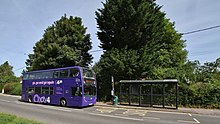Cumnor
 From Wikipedia - Reading time: 10 min
From Wikipedia - Reading time: 10 min
This article needs additional citations for verification. (December 2019) |
| Cumnor | |
|---|---|
 St. Michael's parish church | |
Location within Oxfordshire | |
| Population | 5,755 (2011 Census) |
| OS grid reference | SP4604 |
| Civil parish |
|
| District | |
| Shire county | |
| Region | |
| Country | England |
| Sovereign state | United Kingdom |
| Post town | Oxford |
| Postcode district | OX2 |
| Dialling code | 01865 |
| Police | Thames Valley |
| Fire | Oxfordshire |
| Ambulance | South Central |
| UK Parliament | |
| Website | Cumnor Parish Council |
Cumnor is a village and civil parish 3½ miles (5.6 km) west of the centre of Oxford, England. The village is about 2 miles (3.2 km) south-west of Botley and its centre is west of the A420 road to Swindon. The parish includes Cumnor Hill, (a ribbon development between Cumnor village and Botley), Chawley (at the top of Cumnor Hill), the Dean Court area on the edge of Botley and the outlying settlements of Chilswell, Farmoor, Filchampstead and Swinford. It was within Berkshire until the 1974 local government boundary changes transferred it to Oxfordshire. The 2011 Census recorded the parish population as 5,755.[1]
Amenities
[edit]Cumnor has two public houses, the Vine and the Bear and Ragged Staff. It has a butcher, a hairdresser, a sub-post office and greengrocer and a complementary health clinic. The newsagent closed in 2018. It has two churches: the Church of England parish church of St Michael in the centre of the village and Cumnor United Reformed Church in Leys Road. The village has well established football and cricket clubs, both located in Appleton Road.
Cumnor Primary School, located in the centre of the village has produced many notable pupils. The Oxford School of Music is in Cumnor Hill. Notable residents in October 2008 included novelist Philip Pullman[2] and celebrity chef Sophie Grigson.[3] The composer and conductor Christopher Whelen lived in Cumnor for several years until his death in 1993.


Public transport
[edit]Cumnor is served by the Oxford Bus Company routes 4 and 4B to Abingdon[4] and Oxford and Stagecoach in Oxfordshire Gold route S9 to Oxford and Wantage.[5]
Rivers and streams
[edit]Cumnor parish adjoins the River Thames on its south bank near Bablock Hythe. The centre of Cumnor village lies 1.5 miles to the east. The source of the Osse Stream is a pond in Cumnor.
History
[edit]The earliest known record of Cumnor appears in a Saxon charter of 931 CE as Cumanoran. The Domesday Book of 1086 terms it Comenore. Other medieval spellings include Colmonora and Colmanora. The name derives from Old English for "Cuma's hill-slope". However, a Benedictine called Cumma was Abbot of Abingdon about 730 CE.[6] The parish in the Middle Ages was among the largest in Berkshire. It included Wytham, Seacourt, North Hinksey, South Hinksey and Wootton and was one of several in the Hundred of Hormer.[7] In 1560 Cumnor Place saw the accidental death and rumoured suicide or murder of Amy Robsart, ailing wife of Lord Robert Dudley. The house was pulled down in 1810,[8] because, it was said, her ghost gave locals trouble. In reality the house had become decrepit.
Cumnor includes some houses by Clough Williams-Ellis, the architect noted for his designs for Portmeirion. His Cumnor houses are some of his earliest commissions, including his first commission, Larkbeare (1903–04, completed 1907) on Cumnor Hill, designed whilst he was still a student at the Architectural Association School of Architecture. The other examples are Cutts End House (1911, Appleton Road), Hurstcote (1922, Appleton Road), and Larkbeare Cottage (1910, Cumnor Hill; originally a gardener's cottage associated with Larkbeare). He also designed Cumnor Rise Hospital at a similar time to Larkbeare (designed 1903–1904, completed 1907) but this was demolished in the 1990s. The Kimmeridge Clay Formation outcrops near Cumnor. The dinosaur Cumnoria prestwichii was discovered near Cumnor before 1879 and was named by Harry Govier Seeley in 1888.[9] Thomas Hardy based Lumsdon on Cumnor in his novel Jude the Obscure.

See also
[edit]- Henry Brooke, Baron Brooke of Cumnor (1903–84)
- Ruth Deech, Baroness Deech of Cumnor (born 1943)
- Cumnor Hurst
References
[edit]- ^ UK Census (2011). "Local Area Report – Cumnor Parish (E04008203)". Nomis. Office for National Statistics. Retrieved 6 December 2019.
- ^ Cornwell, John (24 October 2004). "Some enchanted author". The Times Online. Archived from the original on 7 September 2008. Retrieved 6 January 2010.
- ^ Grigson, Sophie (1 March 2007). "Sophie's Guide to the World of Vegetables". The Oxford Times "Weekend". Retrieved 6 January 2010.
- ^ "4 4B Abingdon ∙ Wootton ∙ Cumnor ∙ Botley ∙ City Centre ∙ Wood Farm 4A Elms Rise 4C Dean Court" (PDF). Oxford Bus Company. 1 September 2019. Retrieved 6 December 2019.
- ^ "S9: Wantage - Grove - Oxford" (PDF). Stagecoach in Oxfordshire. 4 August 2019. Retrieved 6 December 2019.
- ^ Ekwall 1960, Cumnor.
- ^ Powell-Smith, Anna. "Cumnor". Open Domesday. Retrieved 9 April 2017.
- ^ "Cumnor Place (Cumnor Hall) (Dudley Castle)". The DiCamillo Companion. Archived from the original on 2 April 2015. Retrieved 8 March 2015.
- ^ Seeley, H. G. (1888). "On Cumnoria, an iguanodont genus founded upon the Iguanodon prestwichi, Hulke". Report of the British Association for the Advancement of Science. 57: 698.
Sources and further reading
[edit]- Ditchfield, PH; Page, William, eds. (1924). "Cumnor". A History of the County of Berkshire. Victoria County History. Vol. IV. assisted by John Hautenville Cope. London: The St Katherine Press. pp. 398–405.
- Ekwall, Eilert (1960) [1936]. Concise Oxford Dictionary of English Place-Names (4th ed.). Oxford: Oxford University Press. Cumnor. ISBN 0198691033.
- Pevsner, Nikolaus (1966). Berkshire. The Buildings of England. Harmondsworth: Penguin Books. pp. 124–126.
 KSF
KSF
